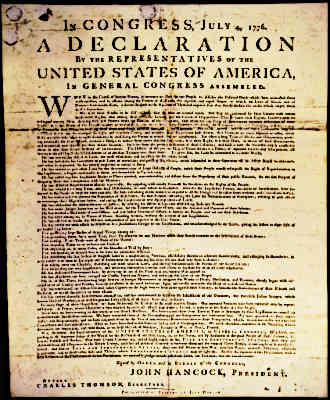Declaration of Independence
What was the Declaration of Independence?
In 1775, war between American colonies and Britain began. Americans fought against British control of the American colonies while Britain wanted to reassert its control and bring all colonies back under its firm control.
The war was still raging in 1776. Meanwhile, a Continental Congress comprising of American representatives decided to officially announce that they were free men and no longer under British control. This declaration famously became the Declaration of Independence.

What was said in the Declaration?
In the Declaration, the Americans expressed their grievances against the British Empire. They mentioned the reasons why they didn’t like the British administration and why they wanted to be free from it.
One famous part of the Declaration stated that “all men are created equal” and that they had rights to “Life, Liberty and the Pursuit of Happiness”. With these words, the American colonies jointly declared independence from Britain.
Who wrote down the Declaration?
The Congress elected five persons to write the Declaration. These included John Adams, Benjamin Franklin, Thomas Jefferson, Robert Livingston and Robert Sherman. After discussion, they agreed that Thomas Jefferson should write down the first draft of the Declaration.
After he had written down the first draft, the rest of the four members of the committee discussed it, made some minor changes and then presented it to the Congress for approval.
Who approved and signed the Declaration?
After the war began in 1775, Americans came together in a Continental Congress, a sort of Parliament comprising of representatives from all American colonies. In 1776, Second Continental Congress took place and it was here that the Declaration was presented for approval by all the representatives.
The Declaration was presented on July 1 but on that date, only 9 states approved it. During this voting, the states of South Carolina and Pennsylvania voted “No”, opposing the Declaration. New York and Delaware also didn’t vote “Yes” and abstained from voting at all.
But the Congress wanted to have maximum support for the Declaration. So a second voting took place on July 2. This time, the previous 9 states who voted “Yes” as well as South Carolina, Pennsylvania and Delaware supported the document.
New York still abstained from voting. So the Declaration was adopted by the Congress with 12 out of 13 votes in favour and one abstention.
What happened after the Declaration?
After adopting the Declaration, it was printed and copies were sent to all American colonies. It was read out in public and printed in newspapers and everyone in the American colonies became aware that they had declared freedom from the British Empire.
The Congress also sent a copy of the Declaration to the British government. Copies of the Declaration were also sent to other governments in Europe and it had reached Germany, Florence and France by the end of the year.
A copy of the Declaration was also sent to George Washington who was the commander-in-chief of the American army at the time. He had the Declaration read aloud to all his soldiers so that it would inspire them for freedom.
- Birth of the USA
- 1st Amendment
- 2nd Amendment
- American Enlightenment
- American National Anthem
- Articles of Confederation 1777
- Betsy Ross
- Bill of Rights
- Birth of USA Timeline
- Christopher Columbus
- Declaration of Independence
- Federalism
- Is the United States a Democracy?
- Isolationism vs. Interventionism
- Liberty Bell
- Pledge of Allegiance
- The Torch of Liberty
- The U.S. Constitution
- Treaty of Paris
- War of Independence
- Washington D.C
- What Is The American Dream?